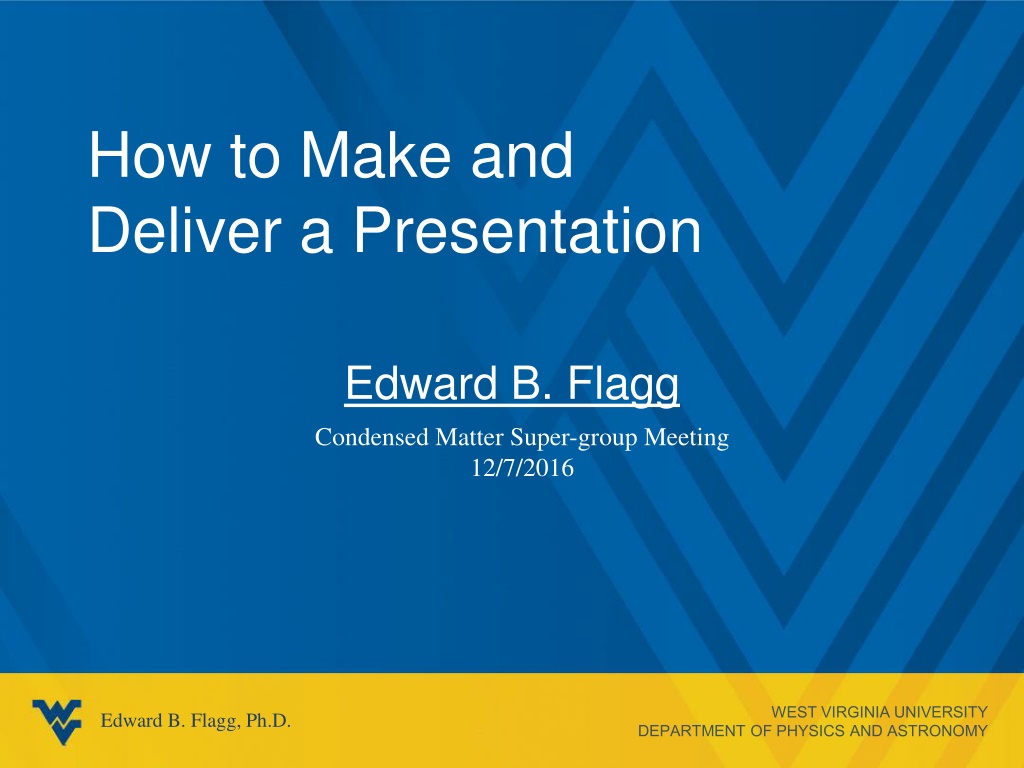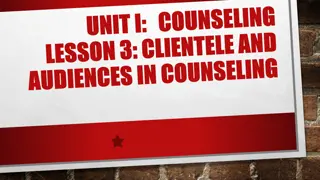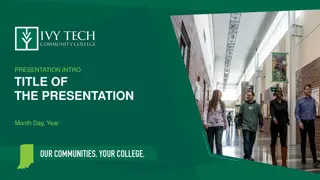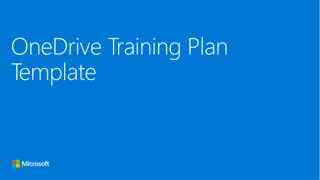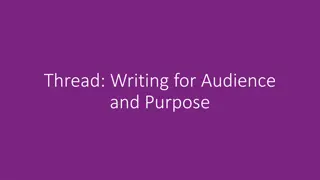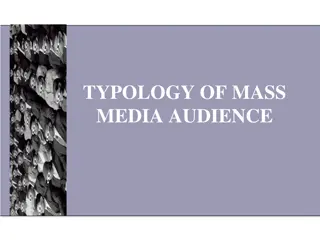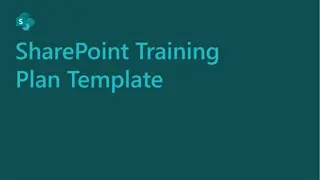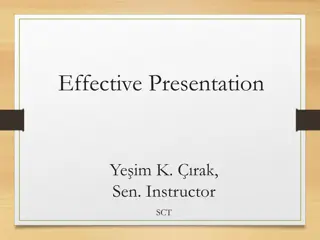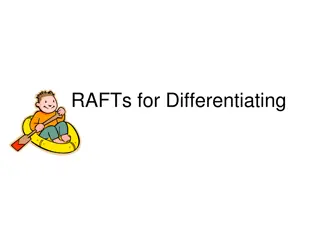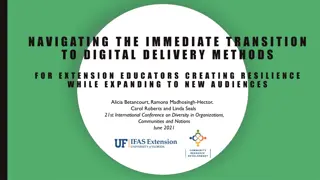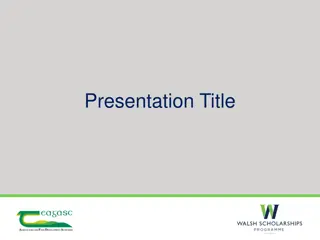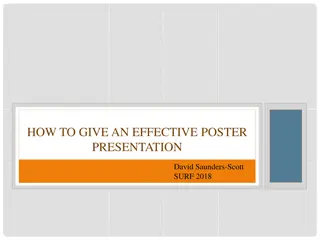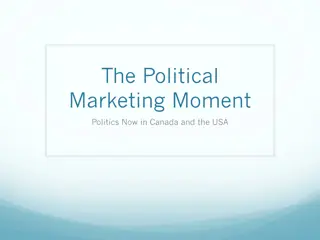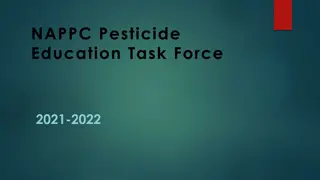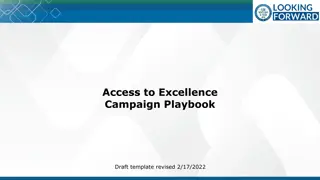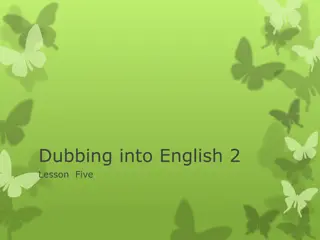Effective Presentation Tips for Engaging Audiences
Understand the importance of presentations, the key elements of a good presentation, audience considerations, organizing your content effectively, utilizing visuals in slides, and essential things to do for a successful delivery.
Download Presentation

Please find below an Image/Link to download the presentation.
The content on the website is provided AS IS for your information and personal use only. It may not be sold, licensed, or shared on other websites without obtaining consent from the author.If you encounter any issues during the download, it is possible that the publisher has removed the file from their server.
You are allowed to download the files provided on this website for personal or commercial use, subject to the condition that they are used lawfully. All files are the property of their respective owners.
The content on the website is provided AS IS for your information and personal use only. It may not be sold, licensed, or shared on other websites without obtaining consent from the author.
E N D
Presentation Transcript
How to Make and Deliver a Presentation Edward B. Flagg Condensed Matter Super-group Meeting 12/7/2016 Edward B. Flagg, Ph.D.
Why do we give presentations? To disseminate our research results To teach others A scientist is always teaching To market ourselves A scientist is also a salesman Relative emphasis changes with context: APS Talk Colloquium Job Talk Marketing Dissemination My estimates. Others may differ. Teaching Edward B. Flagg, Ph.D.
A Good Presentation Comprises Clarity: Organizational, Visual, Oral Content: Include only the necessary Delivery: Slides are a prop to your speech When you start, follow the rules (Experts will sometimes break the rules for effect) Edward B. Flagg, Ph.D.
Consider Your Audience The cardinal rule: Never overestimate your audience If they don t understand, no one will remember it or ask any questions. Audience knowledge More Introduction Less Audience Specialists (e.g., magnetism) Subfield experts (e.g., cond. mat.) Physicists (e.g. plasma, astro) Graduate students Undergraduate students Less More General public Edward B. Flagg, Ph.D.
Get Organized 1. Motivation: a) Why should the audience listen to you? b) Establish the context of your research question. 2. Spoil the punchline: Give the final results right away. 3. Background: Cover only that necessary to understand your novel results. 4. Data and Analysis: a) Present data clearly b) Describe how/why the conclusions were made. Make an outline, but don t show it. (usually) 5. Conclusion(s): Tell em what you told em. Describe potential future work Edward B. Flagg, Ph.D.
Slides add what speech cannot Graphs and plots Pictures Diagrams 0 1 Additional information pathway (visual vs. auditory) A persistent explanation (audience can review earlier points) Edward B. Flagg, Ph.D.
Things to Do Start right: Get the WVU template at https://brand.wvu.edu/ Modify the template: View Master Views Slide Master Scroll up to 1st slide to modify 10 Lorem ipsum 12 Lorem ipsum 14 Lorem ipsum 16 Lorem ipsum 18 Lorem ipsum 20 Lorem ipsum 24 Lorem ipsum 28 Lorem ipsum 32 Lorem ipsum Make it clear: Large fonts nothing smaller than 16 point Use contrasting colors Black on white White on black Yellow on white Blue on black Not like these Make it pretty: Use snap to grid View Show little box/arrow thing Animate slide components Very important Edward B. Flagg, Ph.D.
Things to Avoid No outline (unless your talk is 30+ minutes) No bulleted lists (but remember, experts can break the rules) Don t just read from your slides Few full sentences Experimentalists: no photos of apparatus (diagram if necessary) Theorists: at most one equation per slide; explain all terms Edward B. Flagg, Ph.D.
Bad Slides Obfuscate Source: Optics & Photonics News March 2011, pg 12 Title gives the what but lacks the why Bullets not a list (sentences and fragments) Too many ticks/values Item locations give no information Why open circles? Why dashed line? Legend superfluous Unusual values Unnecessary grid Edward B. Flagg, Ph.D.
Good Slides Illuminate Source: Optics & Photonics News March 2011, pg 12 Title gives the message, the why Data prominent, axes/ticks/labels secondary Information placed at relevant locations (Maybe should have axes labels ) A graph for a presentation has different qualities than a graph for a paper. Avoid using the same figures. Edward B. Flagg, Ph.D.
Check that your graphs contain Error Bars Data Legend Axis Titles Axes Font size 16 Ticks and tick labels Units Edward B. Flagg, Ph.D.
Delivery adds what a slide cannot Enthusiasm! Interaction with audience Words spoken words on slide Speaker gives context and addn l info. Faster info transfer than a paper Edward B. Flagg, Ph.D.
Practice, Practice, Practice 1. Alone, silently 2. Alone, out loud 3. Alone, video yourself 4. In front of labmates/friends 5. In front of research group, including professors Write a script (especially if non-native English speaker) Time yourself: e.g. 10 mins for APS-style, 2 mins for questions Be aware of distracting behaviors: Fidgeting Um, uh, ah, etc. Excessive laser pointer use, or wiggling Check that you have good behaviors: Eye contact with whole audience Body turned toward audience Steady, stable laser pointer use Edward B. Flagg, Ph.D.
The Five Kinds of Questions Question Response Request for Clarification Re-explain 90% of questions Request for Further Information Give more details Apply same principles to different system. Request for Speculation Request for Comparison Probe for misunderstanding. Note similarities/differences. Not a question (Rare) Offer thanks and move on. You have the floor, not them. Edward B. Flagg, Ph.D.
How to Answer Questions The cardinal rule: Don t answer the wrong question Misunderstanding the question Most difficulties in answering 1. Repeat back the question 2. Ask them to clarify the question 3. Offer to discuss afterward Edward B. Flagg, Ph.D.
Oral Qualifier Questions Different purpose than conference questions Committee wants to: Test your knowledge See your analytical skills in action The questions are simpler than you think Work it out step by step In speech or on the board Don t stand thinking silently Identical Pondering quietly Frozen brain panicking Start from the basics Work toward the answer from a more basic point. Don t guess; don t wrack your memory. Edward B. Flagg, Ph.D.
Summary Clarity Content Delivery Never overestimate your audience Knowledge Err to this side Introduction Construct illuminating slides Practice, practice, practice Observe others (both good and bad) Break the rules when necessary Edward B. Flagg, Ph.D.
